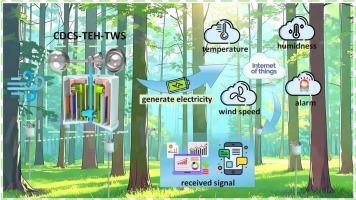A self-powered and self-sensing hierarchical triboelectric-electromagnetic hybrid generator for forest monitoring
IF 9.2
2区 工程技术
Q1 ENERGY & FUELS
引用次数: 0
Abstract
As an environmentally friendly primary renewable energy source, wind energy has enormous potential for development and research. In the field of forest ecosystem monitoring, it can provide sustainable clean energy support for the monitoring system in this domain. Traditional monitoring equipment has significant shortcomings, which are specifically manifested in strong dependence on continuous external energy supply, poor environmental adaptability, and insufficient sustainability of energy supply. To address these issues, this study designed and proposed a centrifugal force-driven conversion structure triboelectric-electromagnetic hybrid generator and triboelectric wind sensor (CDCS-TEH-TWS). Through an innovative multi-level structural design, the device enables adaptive three-level regulation of the triboelectric wind sensor (TWS), triboelectric nanogenerator (TENG), and electromagnetic generator (EMG), all within a compact form factor. The design effectively integrates the complementary strengths of TENG and EMG across various energy harvesting conditions, enhancing power generation efficiency via a wind-speed-matching mechanism, thereby addressing the variable nature of wind in forested areas. Additionally, by combining the device's electrical signals with a long short-term memory (LSTM) deep learning model, the TWS achieves real-time wind speed monitoring and supports a self-sustaining sensing capability. Experimental results showed that under the wind speed condition of 12 m/s, the open-circuit peak voltage of the TENG unit reached 780 V, with an output power of 33.8 mW; the open-circuit peak voltage of the EMG was 15.6 V, and the output power reached 3.042 W. In addition, the CDCS-TEH-TWS system could continuously drive multiple sensors to operate and successfully achieved dynamic monitoring of conventional parameters such as ambient temperature and humidity. Notably, the TWS module, tested based on 8400 sets of sample data, had a detection accuracy of up to 96.43 % for external wind speed and could accurately capture wind speed changes. These results fully confirmed the practical value of the device in constructing a self-powered forest environmental monitoring system and provided a reliable technical solution for related application scenarios.

一种用于森林监测的自供电自传感分层摩擦电-电磁混合发电机
风能作为一种环境友好的初级可再生能源,具有巨大的开发和研究潜力。在森林生态系统监测领域,可为该领域的监测系统提供可持续的清洁能源支持。传统的监测设备存在明显的缺点,具体表现为对外部持续能源供应的依赖性强,环境适应性差,能源供应的可持续性不足。为了解决这些问题,本研究设计并提出了一种离心力驱动的转换结构摩擦电-电磁混合发电机和摩擦电风传感器(CDCS-TEH-TWS)。通过创新的多层次结构设计,该设备可以自适应三电平调节摩擦电风传感器(TWS)、摩擦电纳米发电机(TENG)和电磁发电机(EMG),所有这些都在一个紧凑的外形因素内。该设计有效地整合了TENG和EMG在各种能量收集条件下的互补优势,通过风速匹配机制提高发电效率,从而解决了森林地区风力的多变性。此外,通过将设备的电信号与长短期记忆(LSTM)深度学习模型相结合,TWS实现了实时风速监测,并支持自我维持的传感能力。实验结果表明,在12 m/s风速条件下,TENG机组开路峰值电压达到780 V,输出功率为33.8 mW;EMG的开路峰值电压为15.6 V,输出功率为3.042 W。此外,CDCS-TEH-TWS系统可以连续驱动多个传感器工作,成功实现了对环境温度、湿度等常规参数的动态监测。值得注意的是,基于8400组样本数据测试的TWS模块对外部风速的检测精度高达96.43%,能够准确捕捉风速变化。这些结果充分证实了该装置在构建自供电森林环境监测系统中的实用价值,为相关应用场景提供了可靠的技术解决方案。
本文章由计算机程序翻译,如有差异,请以英文原文为准。
求助全文
约1分钟内获得全文
求助全文
来源期刊

Sustainable Materials and Technologies
Energy-Renewable Energy, Sustainability and the Environment
CiteScore
13.40
自引率
4.20%
发文量
158
审稿时长
45 days
期刊介绍:
Sustainable Materials and Technologies (SM&T), an international, cross-disciplinary, fully open access journal published by Elsevier, focuses on original full-length research articles and reviews. It covers applied or fundamental science of nano-, micro-, meso-, and macro-scale aspects of materials and technologies for sustainable development. SM&T gives special attention to contributions that bridge the knowledge gap between materials and system designs.
 求助内容:
求助内容: 应助结果提醒方式:
应助结果提醒方式:


